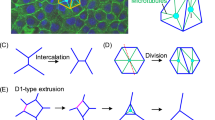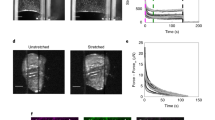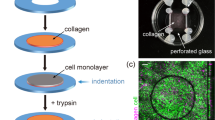Abstract
Epithelial monolayers act as a vital player in a variety of physiological activities, such as wound healing and embryonic development. The mechanical behavior of epithelial monolayers has been increasingly studied with the recent rapid development of techniques. Under dynamic loadings, the creep response of epithelial monolayers shows a power-law dependence on the time with an exponent larger than that of a single cell. Under static loadings, the elastic modulus of epithelial monolayers is nearly two orders of magnitude higher than that of a single cell. To date, there is a lack of a mechanical model that can describe both the dynamic and static mechanical responses of epithelial monolayers. Here, based on the structural features of cells, we establish a multi-scale structural model of cell monolayers. It is found that the proposed model can naturally capture the dynamic and static mechanical properties of cell monolayers. Further, we explore the effects of the cytoskeleton and the membrane moduli on the dynamical power-law rheological responses and static stress-strain relations of a single cell and cell monolayers, respectively. Our work lays the foundation for subsequent studies of the mechanical behavior of more complex epithelial tissues.
摘要
上皮单层在伤口愈合和胚胎发育等各种生理活动中起着十分重要的作用. 随着技术的快速发展, 上皮单层的力学行为得到了广泛的关注与研究. 在阶跃载荷作用下, 上皮单层的蠕变响应表现出对时间的幂律依赖, 且其幂律指数大于单细胞的幂律指数. 而在静态载荷下, 上皮单层的弹性模量比单细胞高出近两个数量级. 到目前为止, 仍然缺乏一个能够同时描述上皮单层动态和静态响应的力学模型. 本文基于细胞的结构特征, 建立了一个多尺度结构的细胞单层模型. 所建模型能够自然地描述细胞单层的动态和静态力学行为. 此外, 本文还探讨了细胞骨架和细胞膜模量分别对单细胞和细胞单层的幂律流变学响应以及应力-应变关系的影响. 这一工作为后续研究更复杂的上皮单层的力学行为奠定了基础.
Similar content being viewed by others
References
Fenderson, and A. Bruce, Molecular Biology of the Cell, 5th ed (Garland Science, New York, 2008).
M. S. Sakar, J. Eyckmans, R. Pieters, D. Eberli, B. J. Nelson, and C. S. Chen, Cellular forces and matrix assembly coordinate fibrous tissue repair, Nat. Commun. 7, 11036 (2016).
M. Cetera, G. R. Ramirez-San Juan, P. W. Oakes, L. Lewellyn, M. J. Fairchild, G. Tanentzapf, M. L. Gardel, and S. Horne-Badovinac, Epithelial rotation promotes the global alignment of contractile actin bundles during Drosophila egg chamber elongation, Nat. Commun. 5, 5511 (2014).
A. Puliafito, L. Hufnagel, P. Neveu, S. Streichan, A. Sigal, D. Kuchnir Fygenson, and B. I. Shraiman, Collective and single cell behavior in epithelial contact inhibition, Proc. Natl. Acad. Sci. USA 109, 739 (2012).
D. Gonzalez-Rodriguez, K. Guevorkian, S. Douezan, and F. Brochard-Wyart, Soft matter models of developing tissues and tumors, Science 338, 910 (2012).
S. He, X. Li, and B. Ji, Mechanical force drives the polarization and orientation of cells, Acta Mech. Sin. 35, 275 (2019).
W. Xi, T. B. Saw, D. Delacour, C. T. Lim, and B. Ladoux, Material approaches to active tissue mechanics, Nat. Rev. Mater. 4, 23 (2018).
B. Ladoux, and R. M. Mège, Mechanobiology of collective cell behaviours, Nat. Rev. Mol. Cell. Biol. 18, 743 (2017).
R. Vincent, E. Bazellières, C. Pérez-González, M. Uroz, X. Serra-Picamal, and X. Trepat, Active tensile modulus of an epithelial monolayer, Phys. Rev. Lett. 115, 248103 (2015).
A. Mongera, P. Rowghanian, H. J. Gustafson, E. Shelton, D. A. Kealhofer, E. K. Carn, F. Serwane, A. A. Lucio, J. Giammona, and O. Campàs, A fluid-to-solid jamming transition underlies vertebrate body axis elongation, Nature 561, 401 (2018).
B. D. Hoffman, G. Massiera, K. M. Van Citters, and J. C. Crocker, The consensus mechanics of cultured mammalian cells, Proc. Natl. Acad. Sci. USA 103, 10259 (2006).
B. Fabry, G. N. Maksym, J. P. Butler, M. Glogauer, D. Navajas, and J. J. Fredberg, Scaling the microrheology of living cells, Phys. Rev. Lett. 87, 148102 (2001).
P. Kollmannsberger, and B. Fabry, Linear and nonlinear rheology of living cells, Annu. Rev. Mater. Res. 41, 75 (2011).
N. Bonakdar, R. Gerum, M. Kuhn, M. Spörrer, A. Lippert, W. Schneider, K. E. Aifantis, and B. Fabry, Mechanical plasticity of cells, Nat. Mater 15, 1090 (2016).
S. Münster, L. M. Jawerth, B. A. Leslie, J. I. Weitz, B. Fabry, and D. A. Weitz, Strain history dependence of the nonlinear stress response of fibrin and collagen networks, Proc. Natl. Acad. Sci. USA 110, 12197 (2013).
N. Khalilgharibi, J. Fouchard, N. Asadipour, R. Barrientos, M. Duda, A. Bonfanti, A. Yonis, A. Harris, P. Mosaffa, Y. Fujita, A. Kabla, Y. Mao, B. Baum, J. J. Muñoz, M. Miodownik, and G. Charras, Stress relaxation in epithelial monolayers is controlled by the actomyosin cortex, Nat. Phys. 15, 839 (2019).
A. R. Harris, and G. T. Charras, Experimental validation of atomic force microscopy-based cell elasticity measurements, Nanotechnology 22, 345102 (2011).
A. R. Harris, L. Peter, J. Bellis, B. Baum, A. J. Kabla, and G. T. Charras, Characterizing the mechanics of cultured cell monolayers, Proc. Natl. Acad. Sci. USA 109, 16449 (2012).
A. R. Bausch, F. Ziemann, A. A. Boulbitch, K. Jacobson, and E. Sackmann, Local measurements of viscoelastic parameters of adherent cell surfaces by magnetic bead microrheometry, Biophys J. 75, 2038 (1998).
G. W. Schmid-Schönbein, K. L. Sung, H. Tözeren, R. Skalak, and S. Chien, Passive mechanical properties of human leukocytes, Biophys.l J. 36, 243 (1981).
O. Thoumine, and A. Ott, Time scale dependent viscoelastic and contractile regimes in fibroblasts probed by microplate manipulation, J. Cell Sci. 110, 2109 (1997).
V. M. Laurent, R. Fodil, P. Cañadas, S. Féréol, B. Louis, E. Planus, and D. Isabey, Partitioning of cortical and deep cytoskeleton responses from transient magnetic bead twisting, Ann. Biomed. Eng. 31, 1263 (2003).
P. Sollich, F. Lequeux, P. Hébraud, and M. E. Cates, Rheology of soft glassy materials, Phys. Rev. Lett. 78, 2020 (1997).
D. E. Ingber, Tensegrity: the architectural basis of cellular mechanotransduction, Annu. Rev. Physiol. 59, 575 (1997).
P. Cañadas, S. Wendling-Mansuy, and D. Isabey, Frequency response of a viscoelastic tensegrity model: Structural rearrangement contribution to cell dynamics, J. BioMech. Eng. 128, 487 (2006).
J. T. Hang, Y. Kang, G. K. Xu, and H. Gao, A hierarchical cellular structural model to unravel the universal power-law rheological behavior of living cells, Nat. Commun. 12, 6067 (2021).
Y. Liu, L. Y. Zhang, B. C. Wang, G. K. Xu, and X. Q. Feng, Why are isolated and collective cells greatly different in stiffness? J. Mech. Phys. Solids 147, 104280 (2021).
J. G. McGarry, and P. J. Prendergast, A three-dimensional finite element model of an adherent eukaryotic cell, Eur. Cell. Mater. 7, 27 (2004).
L. Wang, L. Wang, L. Xu, and W. Chen, Finite element modelling of single cell based on atomic force microscope indentation method, Comput. Math. Methods Med. 2019, 1 (2019).
L. Y. Zhang, Y. Li, Y. P. Cao, and X. Q. Feng, Stiffness matrix based form-finding method of tensegrity structures, Eng. Struct. 58, 36 (2014).
F. Gittes, B. Mickey, J. Nettleton, and J. Howard, Flexural rigidity of microtubules and actin filaments measured from thermal fluctuations in shape., J. Cell Biol. 120, 923 (1993).
R. Kamm, A. K. McVittie, and M. Bathe, On the role of continuum models in mechanobiology, ASME Int. Congr. Mech. Biol. 242, 1 (2000).
R. Farhadifar, J. C. Röper, B. Aigouy, S. Eaton, and F. Jülicher, The influence of cell mechanics, cell-cell interactions, and proliferation on epithelial packing, Curr. Biol. 17, 2095 (2007).
D. Shin, and K. Athanasiou, Cytoindentation for obtaining cell biomechanical properties, J. Orthop. Res. 17, 880 (1999).
J. Chen, and N. Wang, Tissue cell differentiation and multicellular evolution via cytoskeletal stiffening in mechanically stressed microenvironments, Acta Mech. Sin. 35, 270 (2019).
C. Alibert, B. Goud, and J. B. Manneville, Are cancer cells really softer than normal cells? Biol. Cell 109, 167 (2017).
Z. You, L. Zhou, W. Li, C. Huang, and Y. Du, Mechanical microenvironment as a key cellular regulator in the liver, Acta Mech. Sin. 35, 289 (2019).
P. O. Kano, M. Brio, and J. Bailey, Optimal parameter selection in Weeks’ method for numerical Laplace transform inversion based on machine learning, J. Algorithms Comput. Tech. 15, 174830262199962 (2021).
N. Wang, K. Naruse, D. Stamenović, J. J. Fredberg, S. M. Mijailovich, I. M. Tolić-Nørrelykke, T. Polte, R. Mannix, and D. E. Ingber, Mechanical behavior in living cells consistent with the tensegrity model, Proc. Natl. Acad. Sci. U.S.A. 98, 7765 (2001).
T. P. J. Wyatt, J. Fouchard, A. Lisica, N. Khalilgharibi, B. Baum, P. Recho, A. J. Kabla, and G. T. Charras, Actomyosin controls planarity and folding of epithelia in response to compression, Nat. Mater. 19, 109 (2020).
Author information
Authors and Affiliations
Corresponding author
Additional information
This work was supported by the National Natural Science Foundation of China (Grant Nos. 12072252 and 12122210) and the Natural Science Basic Research Plan in Shanxi Province of China (Grant No. 2019JC-02).
Rights and permissions
About this article
Cite this article
Wang, H., Hang, JT., Chang, Z. et al. Static and dynamic mechanics of cell monolayers: A multi-scale structural model. Acta Mech. Sin. 38, 222006 (2022). https://doi.org/10.1007/s10409-022-22006-x
Received:
Accepted:
Published:
DOI: https://doi.org/10.1007/s10409-022-22006-x




